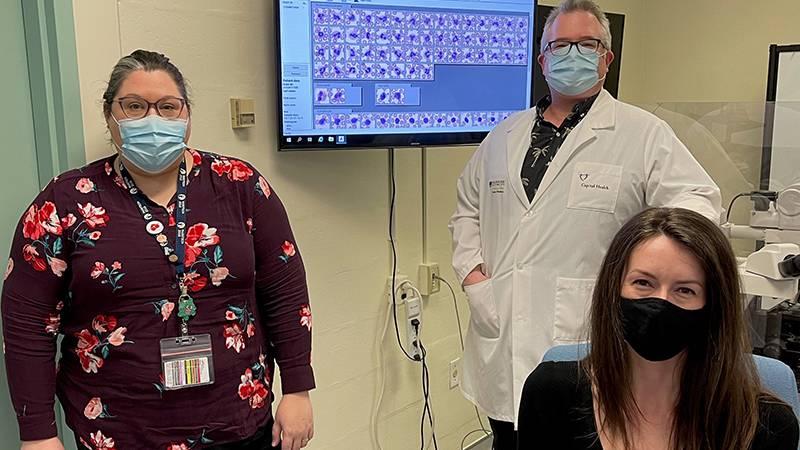
Kimberly Ingalls (left), technical specialist for microscopy, Dr. David Conrad (centre), hematopathologist, and Dr. Tish O’Reilly (right), hematopathologist and medical director of microscopy, say CellaVision – a digital system that uses innovative automation, digital imaging and artificial neural network technology – allows for diagnosis and treatment to take place faster. – Contributed
CellaVision technology combines efficiency with education
Originally published on qe2times.ca.
Advanced technology at the QEII Health Sciences Centre in Halifax is allowing blood laboratories to do more with less — and faster — while at the same time connecting different hospital sites in Nova Scotia.
Thanks to CellaVision, a digital system that uses innovative automation, digital imaging and artificial neural network technology, a blood sample can be taken from a patient at the Cobequid Community Health Centre in Lower Sackville, the Dartmouth General Hospital and soon the Cape Breton Regional Hospital and immediately reviewed by specialists at the QEII.
The time spent waiting for a blood sample to be physically transported to the QEII and analyzed is eliminated, allowing for diagnosis and treatment to take place faster.
“CellaVision is a camera in a box with artificial intelligence. It essentially gives a snapshot of all the cells I need to identify, like white blood cells,” says Dr. David Conrad, a hematopathologist, section head for molecular hematopathology at the QEII and hematopathology residency program director at Dalhousie University.
Hematopathologists are specially trained to diagnose diseases of the blood cells.
By eliminating the need to use a conventional microscope, Dr. Conrad can review a blood sample in half the amount of time it once took him.
This means improved speed of diagnosis for critical cases, such as leukemia, and improved patient care. The digital system also means greater learning opportunities across the province.
“It has enhanced our ability to teach,” says Dr. Tish O’Reilly, a hematopathologist and medical director of microscopy at the QEII and associate director of the hematopathology residency program. “We can save specific cell images in a database.”
Dr. O’Reilly, along with Kimberly Ingalls, an award-winning technical specialist for microscopy at the QEII, trains medical students, residents and medical technologists from across the province.
Through their teaching they are increasing the level of expertise in Nova Scotia, providing the opportunity for everyone who looks at blood cells to see all the different blood abnormalities that contribute to a diagnosis. Greater diagnostic expertise means better patient care everywhere in Nova Scotia.
Using CellaVision’s advanced software, they have the ability at the QEII to categorize all red and white blood cells. Instead of a group of students crowding over a microscope and learning to identify hundreds of blood cells all in the same field of view, the digital system allows them to review and categorize specific cells on a computer screen, making it not only more precise but easier for everyone to view the same cells — and a safer way of learning during the COVID-19 pandemic. The system also allows the QEII team to teach remotely.
“It is much more tailored teaching,” says Kimberly, who received the Canadian Association of Pathologists 2020 Medical Technologist/Technician Award for Continuing Professional Development.
Dr. Conrad is excited not only about the enhanced teaching opportunities, but also to see the CellaVision system expand to Cape Breton. Currently, when a blood sample is taken in Cape Breton and needs to be reviewed by a hematopathologist, the slide must be couriered to Halifax, entered into the digital system and then analyzed. This transfer time can amount to anywhere from eight to 24 hours.
“The technology has taken away the distance between the patient sample and the pathologists in Halifax, who are the experts at looking at those blood cells,” says Dr. Conrad.
With CellaVision technology, patients at the Cape Breton Regional Hospital will no longer have to wait an extra eight to 24 hours for a result.
“We will be able to see them in real time, almost immediately,” says Dr. Conrad. “We will be able to view, in real time, the slides from Cape Breton while we are sitting here in Halifax.”
Inside the microscopy lab at the QEII, Kimberly and her colleagues daily review 175 to 200 blood specimens five days a week. About 10 per cent of those need to be further analyzed by a hematopathologist.
If she is looking at a blood sample in her lab using the CellaVision system and a red flag is raised, Kimberly calls a medical specialist on the phone. They can review the same blood cells together, in different offices, because of CellaVision.
Potentially fatal diseases, such as acute promyelocytic leukemia (APL), can be diagnosed promptly. Patients with APL are at risk of quickly developing blood-clotting or bleeding problems if not treated.
“We are helping treatment happen more quickly,” says Dr. Conrad.